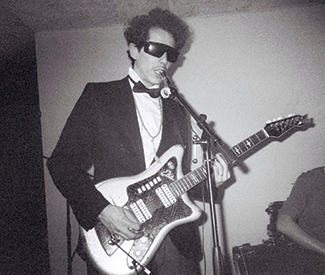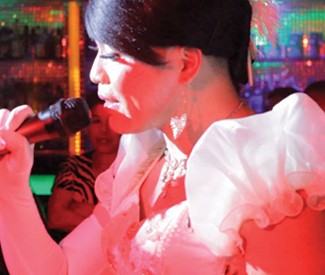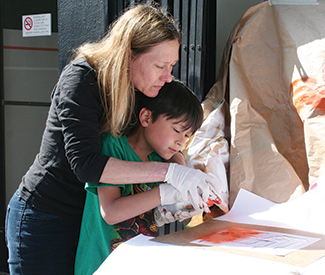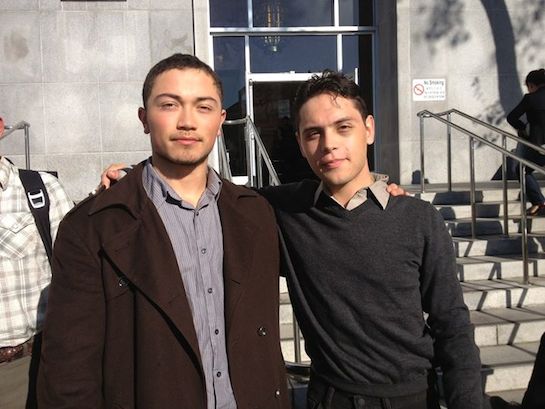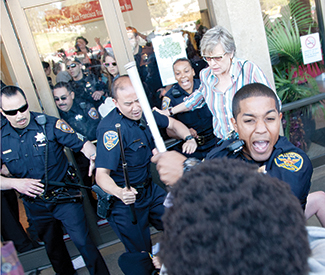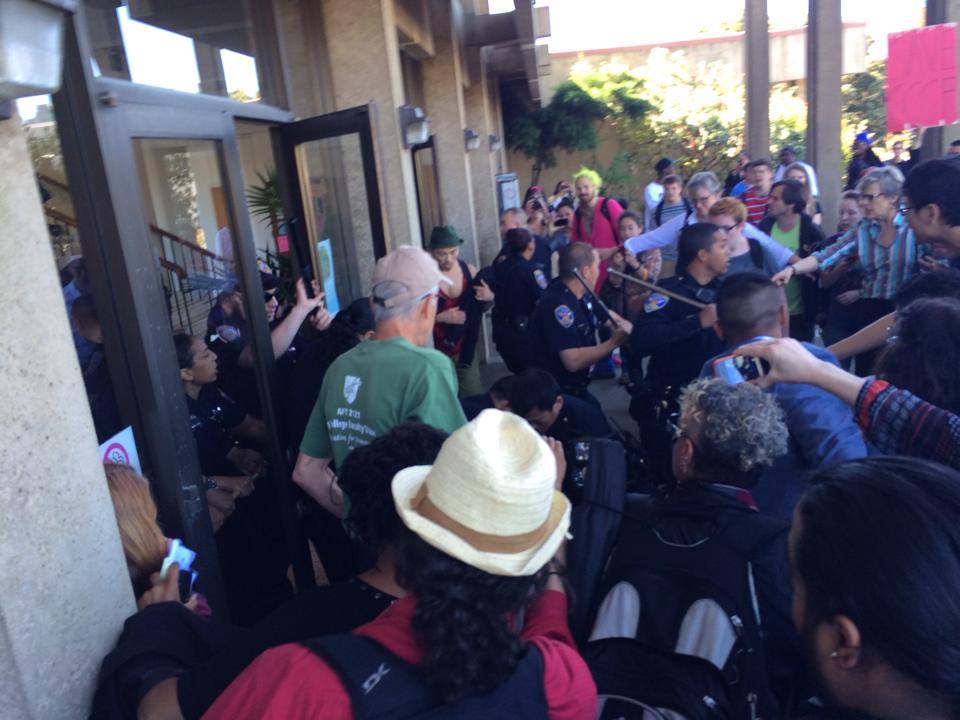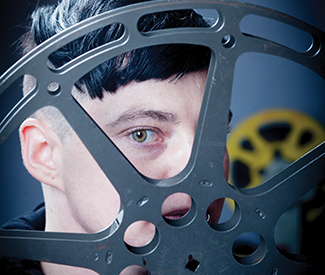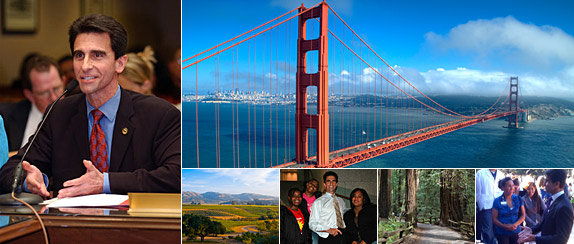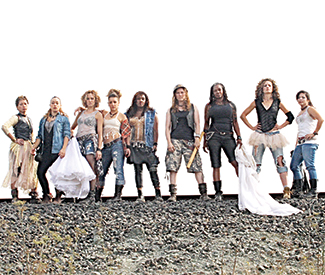Stage listings are compiled by Guardian staff. Performance times may change; call venues to confirm. Reviewers are Robert Avila, Rita Felciano, and Nicole Gluckstern. Submit items for the listings at listings@sfbg.com.
THEATER
OPENING
Communiqué N°10 Exit on Taylor, 277 Taylor, SF; www.cuttingball.com. $10-50. Previews Fri/25-Sat/26, 8pm; Sun/27, 7pm. Opens May 1, 7:30pm. Runs Thu, 7:30; Fri-Sat, 8pm (also Sat, 2pm); Sun, 5pm. Through May 25. Cutting Ball Theater closes its 15th season with the American premiere of Samuel Gallet’s drama inspired by recent racial tensions in France.
The Suit ACT’s Geary Theater, 415 Geary, SF; www.act-sf.org. $20-120. Previews Wed/23-Sat/26 and Tue/29, 8pm (also Sat/26, 2pm); Sun/27, 7pm. Opens April 30, 8pm. Runs Wed-Sat, 8pm (also Sat and May 7 and 14, 2pm); Sun, 2pm (May 18, show at 1pm); Tue, 7pm (May 13, show at 8pm). Through May 18. ACT performs Peter Brook, Marie Hélène Estienne, and Franck Krawcyzk’s music-infused drama about betrayal and resentment adapted from the short story by South African author Can Themba.
BAY AREA
Not a Genuine Black Man Osher Studio, 2055 Center, Berk; www.berkeleyrep.org. $30-45. Previews Wed/23, 7pm; Thu/24, 8pm. Opens Fri/25, 8pm. Runs Wed, 7pm (no shows May 14, 21, or 28); Thu-Sat, 8pm (no shows May 3 or 9-10). Through May 31. Brian Copeland brings his acclaimed, long-running solo show to Berkeley Rep for a 10th anniversary limited run.
ONGOING
E-i-E-i-OY! In Bed with the Farmer’s Daughter NOHSpace, 2840 Mariposa, SF; www.vivienstraus.com. $20. Fri-Sat, 8pm. Through May 10. Vivien Straus performs her autobiographical solo show.
Feisty Old Jew Marsh San Francisco Main Stage, 1062 Valencia, SF; www.themarsh.org. $25-100. Sat, 8pm; Sun, 7pm. Extended through May 4. Charlie Varon performs his latest solo show, a fictional comedy about “a 20th century man living in a 21st century city.”
Foodies! The Musical Shelton Theater, 533 Sutter, SF; www.foodiesthemusical.com. $32-34. Fri-Sat, 8pm. Open-ended. AWAT Productions presents Morris Bobrow’s musical comedy revue all about food.
Pearls Over Shanghai Hypnodrome Theatre, 575 10th St, SF; www.thrillpeddlers.com. $30-35. Thu-Sat, 8pm. Through May 31. Five years ago, Thrillpeddlers breathed new life into a glitter-dusted piece of Sixties flotsam, beautifully reimagining the Cockettes’ raunchy mock-operetta Pearls Over Shanghai (in collaboration with several surviving members of San Francisco’s storied acid-drag troupe) and running it for a whopping 22 months. Written by Cockette Link Martin as a carefree interpretation of a 1926 Broadway play, the baldly stereotyped Shanghai Gesture, it was the perfectly lurid vehicle for irreverence in all directions. It’s back in this revival, once again helmed by artistic director Russell Blackwood with musical direction by Cockette and local favorite Scrumbly Koldewyn. But despite the frisson of featuring some original-original cast members — including “Sweet Pam” Tent (who with Koldewyn also contributes some new dialogue) and Rumi Missabu (regally reprising the role of Madam Gin Sling) — there’s less fire the second time around as the production straddles the line between carefully slick and appropriately sloppy. Nevertheless, there are some fine musical numbers and moments throughout. Among these, Zelda Koznofsky, Birdie-Bob Watt, and Jesse Cortez consistently hit high notes as the singing Andrews Sisters-like trio of Americans thrown into white slavery; Bonni Suval’s Lottie Wu is a fierce vixen; and Noah Haydon (as the sultry Petrushka) is a class act. Koldewyn’s musical direction and piano accompaniment, meanwhile, provide strong and sure momentum as well as exquisite atmosphere. (Avila)
The Provoked Wife Fort Mason Center, Southside Theater, SF; www.generationtheatre.com. $15-35. Thu-Sat, 8pm; Sun, 3pm. Through May 4. Generation Theatre performs Sir John Vanbrugh’s Restoration comedy.
Shit & Champagne Rebel, 1772 Market, SF; shitandchampagne.eventbrite.com. $25. Fri-Sat, 8pm. Open-ended. D’Arcy Drollinger is Champagne White, bodacious blond innocent with a wicked left hook in this cross-dressing ’70s-style white-sploitation flick, played out live on Rebel’s intimate but action-packed barroom stage. Written by Drollinger and co-directed with Laurie Bushman (with high-flying choreography by John Paolillo, Drollinger, and Matthew Martin), this high-octane camp send-up of a favored formula comes dependably stocked with stock characters and delightfully protracted by a convoluted plot (involving, among other things, a certain street drug that’s triggered an epidemic of poopy pants) — all of it played to the hilt by an excellent cast that includes Martin as Dixie Stampede, an evil corporate dominatrix at the head of some sinister front for world domination called Mal*Wart; Alex Brown as Detective Jack Hammer, rough-hewn cop on the case and ambivalent love interest; Rotimi Agbabiaka as Sergio, gay Puerto Rican impresario and confidante; Steven Lemay as Brandy, high-end calf model and Champagne’s (much) beloved roommate; and Nancy French as Rod, Champagne’s doomed fiancé. Sprawling often literally across two buxom acts, the show maintains admirable consistency: The energy never flags and the brow stays decidedly low. (Avila)
Sleeping Cutie: A Fractured Fairy Tale Musical Thick House, 1695 18th St, SF; sleepingcutiemusical.tix.com. $30-40. Thu-Sat, 8pm; Sun, 2pm. Though May 11. Off a Cliff Productions and PlayGround present Diane Sampson and Doug Katsaros’ world-premiere musical.
The Speakeasy Undisclosed location (ticket buyers receive a text with directions), SF; www.thespeakeasysf.com. $70 (gambling chips, $5-10 extra; after-hours admission, $10). Thu-Sat, 7:40, 7:50, and 8pm admittance times. Extended through May 24. Boxcar Theater’s most ambitious project to date is also one of the more involved and impressively orchestrated theatrical experiences on any Bay Area stage just now. An immersive time-tripping environmental work, The Speakeasy takes place in an “undisclosed location” (in fact, a wonderfully redesigned version of the company’s Hyde Street theater complex) amid a period-specific cocktail lounge, cabaret, and gambling den inhabited by dozens of Prohibition-era characters and scenarios that unfold around an audience ultimately invited to wander around at will. At one level, this is an invitation to pure dress-up social entertainment. But there are artistic aims here too. Intentionally designed (by co-director and creator Nick A. Olivero with co-director Peter Ruocco) as a fractured super-narrative — in which audiences perceive snatches of overheard stories rather than complete arcs, and can follow those of their own choosing — there’s a way the piece becomes specifically and ever more subtly about time itself. This is most pointedly demonstrated in the opening vignettes in the cocktail lounge, where even the ticking of Joe’s Clock Shop (the “cover” storefront for the illicit 1920s den inside) can be heard underscoring conversations (deeply ironic in historical hindsight) about war, loss, and regained hope for the future. For a San Francisco currently gripped by a kind of historical double-recurrence of the roaring Twenties and dire Thirties at once, The Speakeasy is not a bad place to sit and ponder the simulacra of our elusive moment. (Avila)
“Standing On Ceremony: The Gay Marriage Plays” New Conservatory Theatre Center, 25 Van Ness, SF; www.nctcsf.org. $25-45. Wed/23-Sat/26, 8pm; Sun/27, 2pm. New Conservatory Theatre Center performs short plays about marriage equality by Mo Gaffney, Neil LaBute, Wendy MacLeod, Paul Rudnick, and others.
Tipped & Tipsy Marsh Studio Theater, 1062 Valencia, SF; www.themarsh.org. $20-50. Sat, 5pm; Sun, 7pm. Extended through May 17. Last fall’s San Francisco Fringe Festival began on a high note with Jill Vice’s witty and deft solo, Tipped & Tipsy, and the Best of Fringe winner is now enjoying another round at solo theater outpost the Marsh. Without set or costume changes, Vice (who developed the piece with Dave Dennison and David Ford) brings the querulous regulars of a skid-row bar to life both vividly and with real quasi-Depression-Era charm. She’s a protean physical performer, seamlessly inhabiting the series of oddball outcasts lined up each day at Happy’s before bartender Candy — two names as loaded as the clientele. After some hilarious expert summarizing of the dos and don’ts of bar culture, a story unfolds around a battered former boxer and his avuncular relationship with Candy, who tries to cut him off in light of his clearly deteriorating health. Her stance causes much consternation, and even fear, in his barfly associates, while provoking a dangerous showdown with the bar’s self-aggrandizing sleazeball owner, Rico. With a love of the underdog and strong writing and acting at its core, Tipsy breezes by, leaving a superlative buzz. (Avila)
The World’s Funniest Bubble Show Marsh San Francisco, 1062 Valencia, SF; www.themarsh.org. $8-11. Sun, 11am. Extended through May 25. The popular, kid-friendly show by Louis Pearl (aka “The Amazing Bubble Man”) returns to the Marsh.
BAY AREA
The Coast of Utopia Ashby Stage, 1901 Ashby, Berk; www.shotgunplayers.org. $20-35 (three-show marathon days, $100-125). Three-play marathon Sat/26. Part Three: Salvage runs through Sun/27. Check website for showtime info. Shotgun Players performs Tom Stoppard’s epic The Coast of Utopia trilogy.
East 14th Marsh Berkeley, 2120 Allston, Berk; www.themarsh.org. $20-50. Fri/25, 8pm; Sat/26, 8:30pm. Don Reed’s hit autobiographical solo show returns to the Marsh Berkeley.
Fences Marin Theatre Company, 397 Miller, Mill Valley; www.marintheatre.org. $37-58. Tue and Thu-Sat, 8pm (also Thu/24, 1pm; May 3 and 10, 2pm); Wed, 7:30pm; Sun, 2 and 7pm. Through May 11. Marin Theatre Company performs August Wilson’s Pulitzer- and Tony-winning drama, with an all-star cast of Bay Area talent: Carl Lumbly, Steven Anthony Jones, and Margo Hall.
Geezer Marsh Berkeley, 2120 Allston, Berk; www.themarsh.org. $25-50. Thu/24, 8pm; Sat/26, 5pm. Geoff Hoyle moves his hit comedy about aging to the East Bay.
The Hound of the Baskervilles Mountain View Center for the Performing Arts, 500 Castro, SF; www.theatreworks.org. $19-73. Wed/23, 7:30pm; Thu/24-Sat/26, 8pm (also Sat/26, 2pm); Sun/27, 2 and 7pm. TheatreWorks performs Stephen Canny and John Nicholson’s comedic send-up of Sherlock Holmes.
Johnny Guitar, the Musical Masquers Playhouse, 105 Park Place, Point Richmond; www.masquers.org. $22. Fri/25-Sat/26, 8pm. Masquers Playhouse performs the off-Broadway hit based on the campy Joan Crawford Western.
The Letters Harry’s UpStage, Aurora Theatre Company, 2081 Addison, Berk; www.auroratheatre.org. $28-32. Previews Wed/23, 8pm. Opens Thu/24, 8pm. Runs Wed-Sat, 8pm; Sun, 2pm. Through June 1. Aurora Theatre Company showcases its new second-stage performance space with John W. Lowell’s suspenseful thriller.
Sleuth Center REPertory Company, 1601 Civic, Walnut Creek; www.centerrep.org. $33-54. Wed/23, 7:30pm; Thu/24-Sat/26, 8pm (also Sat/26, 2:30pm). Center REPertory Company performs Anthony Shaffer’s classic, Tony-winning thriller.
Smash Dragon Theatre, 2120 Broadway, Redwood City; www.dragonproductions.net. $30. Thu-Sat, 8pm; Sun, 2pm. Through May 4. Dragon Theatre performs Jeffrey Hatcher’s political comedy.
Tribes Berkeley Repertory Theatre, Roda Theatre, 2015 Addison, Berk; www.berkeleyrep.org. $29-99. Tue and Thu-Sat, 8pm (also Sat, 2pm); Wed and Sun, 7pm (also Sun, 2pm; no 2pm show May 18). Through May 18. Berkeley Rep performs Nina Raine’s family drama about a young deaf man who comes of age.
The 25th Annual Putnam County Spelling Bee Julia Morgan Theater, 2640 College, Berk; www.berkeleyplayhouse.org. $18-60. Fri, Thu/24, and May 1, 7pm; Sat, 1 and 6pm; Sun, noon and 5pm. Through May 4. Berkeley Playhouse performs the Tony-winning musical comedy.
Wittenberg Aurora Theatre, 2081 Addison, Berk; www.auroratheatre.org. $32-60. Tue, 7pm; Wed-Sat, 8pm; Sun, 2 and 7pm. Through May 4. Aurora Theatre Company performs David Davalos’ comedy about reason versus faith.
PERFORMANCE/DANCE
BATS Improv Bayfront Theater, B350 Fort Mason Center, SF; www.improv.org. $20. This week: “Super Scene,” Fri/25, 8pm. “Spring Musical,” Sat/26, 8pm.
“Bay Area National Dance Week” Various locations; www.bayareadance.org. April 25-May 4. This year’s theme is “iconic dance moves from pop culture,” and kicks off with an audience-participation performance in Union Square. Other events include film screenings, free classes, outdoor dance performances, and more.
“Carnaval San Francisco King + Queen Competition” Brava Theater, 2781 24th St, SF; www.carnavalsanfrancisco.org. Sat/26, 7pm. $15. Who will lead the Grand Parade on May 25? Check out this dance-heavy competition to see this year’s king and queen win their crowns.
Caroline Lugo and Carolé Acuña’s Ballet Flamenco Peña Pachamama, 1630 Powell, SF; www.carolinalugo.com. April 30, May 4, 10-11, 17, and 25, 6:15pm. $15-19. Flamenco performance by the mother-daughter dance company, featuring live musicians.
Company C Contemporary Ballet ODC Theater, 3153 17th St, SF; www.odcdance.org. Fri/25-Sat/26 and May 1-3, 8pm (also Sat/26, 8pm). $25-48. Also May 8-10, 8pm; May 11, 2pm, $25-48, Lesher Center for the Arts, 1601 Civic, Walnut Creek; www.lesherartscenter.org. With two world premieres by Maurice Causey and Charles Moulton.
“Cynic Cave” Lost Weekend Video, 1034 Valencia, SF; aparnaeliza.eventbrite.com. Sat/26, 8 and 10pm. $12. Comedy with Aparna Nancherla and Eliza Skinner.
“Dream Queens Revue” Aunt Charlie’s Lounge, 133 Turk, SF; www.dreamqueensrevue.com. Wed/23, 9:30pm. Free. Drag with Collette LeGrande, Ruby Slippers, Sophilya Leggz, Bobby Ashton, and more.
“The Eye of Horus” Jessie Square, 736 Mission, SF; www.dancersgroup.org. Thu/24, Sat/26, Mon/28, April 30, and May 3, 12:30pm. Free. Dancers’ Group and Yerba Buena Gardens Festival present a new, site-specific work by Sara Shelton Mann.
Feinstein’s at the Nikko 222 Mason, SF; www.feinsteinssf.com. This week: Peter Cincotti, Thu/24-Fri/25, 8pm, $55-70; Countess Katya Smirnoff-Skyy in “Back in the USSR: A Voyage Into the Beatles Songbook,” Sun/27, 7pm, $30-45.
“Femprov Fest” Tides Theater, 533 Sutter, SF; www.femprovfest.com. Thu/24-Sat/26, 7:30 and 9:30pm. $20. Improv company Leela-SF presents this festival of female-centric improv ensembles and sketch comedy groups.
“The Five Deadly Improvisers” Stage Werx, 446 Valencia, SF; www.fivedeadly.com. Fri/25-Sat/26, 8pm. $20. Improvised kung fu movies.
“Magic at the Rex” Hotel Rex, 562 Sutter, SF; www.magicattherex.com. Sat, 8pm. Ongoing. $25. Magic and mystery with Adam Sachs and mentalist Sebastian Boswell III.
“Odd Salon: Secret” DNA Lounge, 373 11th St, SF; www.dnalounge.com. Tue/29, 7-10pm. $15. Six storytellers sharing tales of “the classified and covert, the clandestine, the cryptic, and the concealed.”
“Out of Line Improv” Stage Werx, 446 Valencia, SF; outoflineimprov.brownpapertickets.com. Sat, 10:30pm. $12. Ongoing. A new, completely improvised show every week.
“Places We Remember, Songs We Can’t Forget” Alfred’s Steakhouse, 659 Merchant, SF; joescabaret.com/tickets. Sat/26, 8pm. $75 (includes show, shared plates, and open bar). Benn Bacot, Josh Black, and Marilyn Cooney sing cabaret tunes.
“San Francisco Comedy College” Purple Onion at Kells, 530 Jackson, SF; www.purpleonionatkells.com. $5-10. “New Talent Show,” Wed-Thu, 7. Ongoing. “The Cellar Dwellers,” stand-up comedy, Wed-Thu, 8:15pm and Fri-Sat, 7:30pm. Ongoing.
Sean Dorsey Dance Z Space, 450 Florida, SF; www.seandorseydance.com. Thu/22-Sat/24, 8pm. $15-25. The dance company performs a world premiere excerpt from Dorsey’s The Missing Generation, based on Dorsey’s interviews with long-time survivors of the early AIDS epidemic, plus a return engagement of Lou, based on the diaries of transgender activist Lou Sullivan.
“The Seven Deadly Pleasures” ACT Costume Shop, 1117 Market, SF; www.goathall.org. Wed/22-Sat/26, 8pm; Sun/27, 4pm. $20-35. Goat Hall Productions presents the world premiere of Allison Lovejoy and Geoff Ball’s cabaret rock opera.
“Smoke” Shelton Theater, 533 Sutter, SF; www.sheltontheater.org. Fri/25-Sat/26, 8pm. $38. Lori Rivera performs Joe Ortiz’s solo cabaret show about two different women.
“So Bent: A Series of Queer Performances” SF Art Institute, 800 Chestnut, SF; Facebook: So Bent A Series of Queer Performances at SFAI. Fri/25, noon-1pm. Free. Radical opera singer Juliana Snapper performs At Each Other’s Throats. Also May 1, 5-7pm, Monique Jenkinson performs Instrument, with a Q&A to follow.
“Terminator Too: Judgment Play” DNA Lounge, 373 11th St, SF; www.dnalounge.com. May 1, 9pm. $25-50. The creators of Point Break Live! take on James Cameron’s 1991 sci-fi classic, with an audience member picked on the night of the show to embody Schwarzenegger’s iconic role.
“Tickled Pink! Comedy” Café Royale, 800 Post, SF; www.tpinkcomedy.com. Mon/28, 8pm. Free. Comedy with Hayden Griff-Neil, Corrie Gibson, Pete Munoz, and more.
“Under the Influence” Emerald Tablet, 80 Fresno, SF; www.emtab.org. Fri/26, 7:30pm. $5. Five artists perform work by one of their major influences, followed by an original work created for this show.
“The United States of Asian America Festival 2014” This week: Stage Werx, 446 Valencia, SF; www.apiculturalcenter.org. Thu/24, 7:30pm. $20. “In the Crosshairs: A Show About Hair” with Thao P. Nguyen and Martha Rynberg.
“Venus and Adonis” Exit on Taylor, 277 Taylor, SF; www.cuttingball.com. Sun/27, 1pm. Free. Cutting Ball’s Hidden Classics Reading Series hosts this solo-performance adaptation of the Shakespeare poem.
BAY AREA
“Hexenfest” Uptown Nightclub, 1928 Telegraph, Oakl; www.hexenfest.net. Sat/26, 8pm. $25. Over 20 local musician, dancers, and other artists celebrating Paganism.
Mark Morris Dance Group Zellerbach Hall, UC Berkeley, Bancroft at Telegraph, Berk; www.calperformances.org. Fri/25-Sat/26, 8pm; Sun/27, 3pm. $30-110. World premiere of the full-length Acis and Galatea, with the Philharmonia Baroque Orchestra and Chorale.
“MarshJam Improv Comedy Show” Marsh Berkeley, 2120 Allston, Berk; www.themarsh.org. Fri, 8pm. Ongoing. $10. Improv comedy with local legends and drop-in guests.
“Planet Snowvio” UC Berkeley Art Museum/Pacific Film Archive, 2626 Bancroft, Berk; www.jaycritchley.com. Sun/27, 2pm. Free. Staged reading of Jay Critchley’s experimental musical inspired by the meeting of Mario Savio and Edward Snowden.
“Same-Sex Ballroom Dance Championship” Just Dance Ballroom, 2500 Embarcadero, Oakl; www.aprilfollies.com. Sat/26, competition, 10am-5:30pm; beginning lessons, 6:30-7:30pm; showcase of champions 8-11pm. $15-35. Competition containing a wide range of styles, including Argentine tango, salsa, West Coast swing, and many more. An open social dance follows the competition and performances.
“SwapFest 2014” MilkBar, 851 81st Ave, Oakl; www.milkbar.org. Thu/24, 8pm. $10. Also Sat/26, 8pm, $10, Temescal Art Center, 511 48th St, Oakl; www.milkbar.org. Dance, music, and more — including audio installations housed in U-Haul trailers. *

